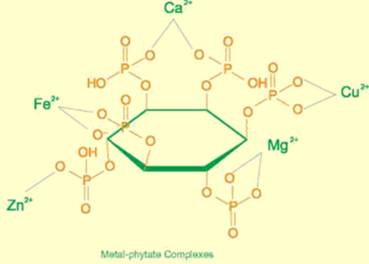Particularly in those whose diet relies heavily on high phytic-acid containing plant foods
An excess of phytic acid presence in the diet can cause mineral deficiencies in the body by chelating certain minerals and forming phytate -phytic acid can bind to positively charged mineral ions (cations)in the GI tract due to the negative charges on its phosphate (P) groups, which give phytic acid its chelative (binding) properties over a broad pH range. Minerals at risk of being bound by phytic acid include multivalent transition metals: magnesium (Mg2+), calcium (Ca2+), iron Fe2+), zinc (Zn2+), manganese (Mn2+), copper(Cu2+), cobalt (Co2+).
- Long-term, an early sign of phytic acid's effects is chronic tooth decay

Phytic acid negatively impacts utilization of protein and starch/carbohydrate by inhibiting enzymes needed for their digestion:
• Pepsin to break down protein in the stomach
• Trypsin for protein digestion in the small intestine;
• Amylase to convert starch into sugars
Tannenbaum and others. Vitamins and Minerals, in Food Chemistry, 2nd edition. OR Fennema, ed. Marcel Dekker, Inc., New York, 1985, p 445.
M and Krikorian D. Inhibition of trypsin activity in vitro by phytate. Journal of Agricultural and Food Chemistry 1982 30(4):799-800.
There are several tactics you can use to reduce or mitigate the health-detrimental effects of excess phytate in the diet. To increase digestibiiity and nutrient bioavailability;